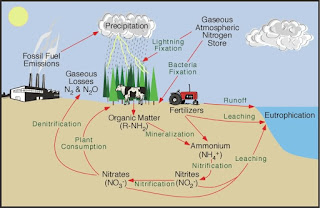
Ammonia & Bio-Fuels
I would like to complete the picture from David Cohen a bit by stressing the free use of bacteria in delivering nitrogen for all sort of plants in sufficient amount. The amount of artificial fertilizer used in the world could be reduced a lot, if the knowledge about Nitrogen fixing bacterias, which already exists, would be transferred to all the farmers around the world. What about spreading the good news via TV and the usually good broadcasts like the "Discovery Channel" or BBC documentations.
I'm only a software developer, but i learned a lot in the last two years about farming through the german forum about peak oil.
The solution for delivering enough nitrogen to the plants at very low costs is called "Biological Nitrogen Fixation".
Legumes such as clover or beans already use that process ever since. Today this process can be transferred also to non-legume plants like rice, wheat, maize etc... In Brazil this is used since a quite few years: (" Boddey, R. M., S. Urquiaga, V. Reis, and J. Döbereiner. 1991. Biological nitrogen fixation associated with sugar cane. Plant Soil 137:111-117.". by implementing the bacteria called Acetobacter diazotrophicus in the roots and stems. So this bacteria is doing now the work of the fertilizer refineries. Brazil already has a quite low demand for artificial fertilizer despite his huge areas of sugar cane.
I would like to complete the picture from David Cohen a bit by stressing the free use of bacteria in delivering nitrogen for all sort of plants in sufficient amount. The amount of artificial fertilizer used in the world could be reduced a lot, if the knowledge about Nitrogen fixing bacterias, which already exists, would be transferred to all the farmers around the world. What about spreading the good news via TV and the usually good broadcasts like the "Discovery Channel" or BBC documentations.
I'm only a software developer, but i learned a lot in the last two years about farming through the german forum about peak oil.
The solution for delivering enough nitrogen to the plants at very low costs is called "Biological Nitrogen Fixation".
Legumes such as clover or beans already use that process ever since. Today this process can be transferred also to non-legume plants like rice, wheat, maize etc... In Brazil this is used since a quite few years: (" Boddey, R. M., S. Urquiaga, V. Reis, and J. Döbereiner. 1991. Biological nitrogen fixation associated with sugar cane. Plant Soil 137:111-117.". by implementing the bacteria called Acetobacter diazotrophicus in the roots and stems. So this bacteria is doing now the work of the fertilizer refineries. Brazil already has a quite low demand for artificial fertilizer despite his huge areas of sugar cane.
In the last years scientist discovered other bacterias for the non-leguminous plants:
For wheat: : Azospirillum brasilense (=Spirillum lipoferum)
For soja: Bradyrhizobium japonicum
For rape (Brassica napus): Azorhizobum caulinodans (the transfer process is enhanced together with Naringenin, which you can find in simple tomato concentrate from your local supermarket ;-) )
To use these bacterias (you can buy them already per Internet) one just has to inoculate the seed with a solution of water and sugar together with a certain amount (from a bottle) a few hours before the sowing e.g. in a small mobile concrete mixer for a single field or in a big concrete mixer for a whole landscape.
The only restriction for the best results is a good soil. Like you can't beat an old horse to win the famous races in the world you can't get super yiels from a soil which has been "totured" by the massive use of artificial fertilizer.
A long crop rotation together with cover crops for green manure would certainly enhance the soil quality. Another possibility would be to plant trees in rows every 30-50 yards in the fields (for getting wood for constructions or for the oven and for getting a protection of sun, wind and too much transpiration in dry areas). This method is called Agroforestry and which is i think an ancient culture which is now revived e.g. in Europe (Project SAFE = Silvoarable Agroforestry For Europe). Very important is to cut the roots of the trees which are growing into the field by not squeezing the water for the plants.
Here are some links for deeper information. What really sad is, is that texts that are easy to understand are quite seldom in the net (Wikipedia e.g. has only few information about this biological "sensation"):
For wheat: : Azospirillum brasilense (=Spirillum lipoferum)
For soja: Bradyrhizobium japonicum
For rape (Brassica napus): Azorhizobum caulinodans (the transfer process is enhanced together with Naringenin, which you can find in simple tomato concentrate from your local supermarket ;-) )
To use these bacterias (you can buy them already per Internet) one just has to inoculate the seed with a solution of water and sugar together with a certain amount (from a bottle) a few hours before the sowing e.g. in a small mobile concrete mixer for a single field or in a big concrete mixer for a whole landscape.
The only restriction for the best results is a good soil. Like you can't beat an old horse to win the famous races in the world you can't get super yiels from a soil which has been "totured" by the massive use of artificial fertilizer.
A long crop rotation together with cover crops for green manure would certainly enhance the soil quality. Another possibility would be to plant trees in rows every 30-50 yards in the fields (for getting wood for constructions or for the oven and for getting a protection of sun, wind and too much transpiration in dry areas). This method is called Agroforestry and which is i think an ancient culture which is now revived e.g. in Europe (Project SAFE = Silvoarable Agroforestry For Europe). Very important is to cut the roots of the trees which are growing into the field by not squeezing the water for the plants.
Here are some links for deeper information. What really sad is, is that texts that are easy to understand are quite seldom in the net (Wikipedia e.g. has only few information about this biological "sensation"):
